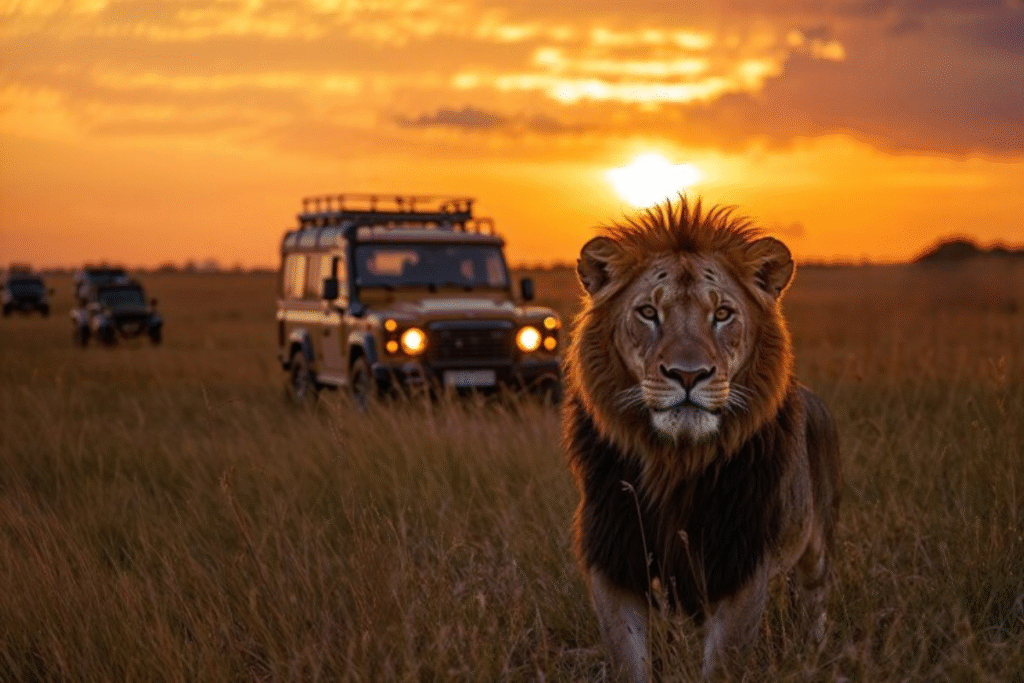Overview : Discover the Magic of Wilderness Travel in Africa
Wilderness travel in Africa is more than just a vacation—it’s an unforgettable journey into the heart of nature. From vast savannas and lush rainforests to arid deserts and remote mountains, Africa offers some of the most untouched and diverse wilderness experiences on Earth.
Whether you’re tracking gorillas in Uganda, camping in Namibia’s deserts, or watching the Great Migration in the Serengeti, wilderness travel in Africa connects you with raw, breathtaking landscapes and authentic wildlife encounters that can’t be found anywhere else.
In this comprehensive guide, we’ll explore the top wilderness destinations in Africa, how to plan your trip, what to pack, safety tips, and more. This content is designed to help travelers, wildlife lovers, and adventurers make the most of their African journey—all while following SEO best practices to ensure you find the information you need easily.
What is Wilderness Travel in Africa?
Wilderness travel refers to exploring remote, natural areas that are largely untouched by modern development. In Africa, this often means venturing into national parks, private reserves, or protected ecosystems where human presence is minimal and wildlife is abundant.
Unlike regular tourism, wilderness travel focuses on deep immersion in nature, often involving:
- Off-grid accommodations (e.g., tented camps, eco-lodges)
- Wildlife tracking on foot or in vehicles
- Minimal infrastructure (no cities or resorts nearby)
- Cultural interactions with indigenous communities
It’s perfect for travelers seeking solitude, adventure, and genuine connection with the Earth.
Top 7 Wilderness Travel Destinations in Africa
1. Okavango Delta, Botswana
A UNESCO World Heritage Site, the Okavango Delta is a lush oasis in the middle of the Kalahari Desert. Famous for:
- Mokoro (dugout canoe) safaris
- Huge populations of elephants, hippos, and birds
- Luxury camps and authentic bush experiences
2. Serengeti National Park, Tanzania
Home to the world-famous Great Migration, the Serengeti offers sweeping plains filled with:
- Wildebeest, zebras, and big cats
- Year-round wildlife viewing
- Iconic safari landscapes
3. Bwindi Impenetrable Forest, Uganda
Perfect for wilderness travelers seeking rare encounters with:
- Mountain gorillas in their natural habitat
- Dense, misty forests and incredible biodiversity
- Small eco-lodges and guided trekking experiences
4. Namib Desert, Namibia
A surreal wilderness of towering dunes and desert-adapted wildlife, including:
- Sossusvlei and Dead Vlei (famous salt and clay pans)
- Rare desert elephants and black rhinos
- Opportunities for stargazing and 4×4 desert safaris
5. Skeleton Coast, Namibia
Known as one of the most remote areas in the world, with:
- Shipwrecks, towering sand dunes, and roaring ocean surf
- Desert lions, brown hyenas, and seal colonies
- Extreme adventure and isolation
6. Zambezi Valley, Zambia & Zimbabwe
This untamed region offers:
- Canoe safaris along the Zambezi River
- Close encounters with elephants, crocs, and hippos
- Proximity to Victoria Falls
7. Ruaha National Park, Tanzania
Often overlooked, this vast wilderness boasts:
- One of Africa’s largest lion populations
- Baobab-dotted landscapes and fewer tourists
- A true off-the-beaten-path experience
Essential Tips for Planning a Wilderness Trip
H2: Decide on the Right Destination for You
- Solo travelers may prefer smaller parks or guided group tours
- Families should choose malaria-free zones like parts of South Africa
- Photographers may opt for Botswana or Tanzania during migration season
Choose the Right Type of Safari
- Self-drive safaris offer flexibility (ideal in South Africa)
- Guided safaris provide safety and expert wildlife insights
- Walking safaris offer an immersive, ground-level experience
H2: Work with Trusted Operators
Look for companies that are:
- Licensed and insured
- Committed to ethical travel and conservation
- Reviewed positively on platforms like TripAdvisor or SafariBookings
What to Pack for Wilderness Travel in Africa
Packing right can make or break your wilderness trip. Here’s what you’ll need:
H3: Clothing
- Neutral colors (tan, olive, beige)
- Long sleeves and pants for sun and insect protection
- Lightweight layers for temperature shifts
Gear
- Binoculars and camera with zoom lens
- Reusable water bottle and purification tablets
- Insect repellent (DEET-based)
H3: Essentials
- Travel insurance documents
- Passport and visa copies
- Sunscreen and personal first-aid kit
Safety and Health in the African Wilderness
H2: Stay Safe Around Wildlife
- Always listen to your guide
- Never approach animals on foot unless with a licensed tracker
- Stay in your vehicle in national parks
H2: Health Precautions
- Get necessary vaccinations (e.g., yellow fever, hepatitis A)
- Take anti-malaria medication as prescribed
- Drink bottled or purified water
Best Time to Travel for Wilderness Adventures
Africa’s climate varies, but here’s a general breakdown:
| Region | Best Time to Visit | Highlights |
|---|---|---|
| East Africa (Kenya, Tanzania) | June–October | Dry season, Great Migration |
| Southern Africa (Botswana, Namibia) | May–September | Dry season, fewer mosquitoes |
| Central Africa (Uganda, Rwanda) | June–September | Gorilla trekking prime time |
Avoid the rainy season if you want easier wildlife sightings and better road conditions.
Wildlife You Can Expect to See
Wilderness travel in Africa isn’t just about the “Big Five” (lion, leopard, elephant, rhino, buffalo)—although you’ll likely see them. Depending on your destination, you might also encounter:
- Cheetahs in the Serengeti and Kalahari
- Gorillas and chimpanzees in Uganda and Rwanda
- Desert-adapted wildlife in Namibia
- Colorful birdlife, including bee-eaters, eagles, and flamingos
Ethical Travel and Conservation in Africa
Wilderness areas in Africa face threats like poaching, habitat loss, and over-tourism. As a responsible traveler, you can:
- Choose lodges that support local communities
- Avoid plastic and respect wildlife boundaries
- Donate or volunteer with reputable conservation groups
Your travel choices directly impact conservation success.
How to Choose a Wilderness Travel Tour or Safari Operator
Look for:
- Sustainability credentials (e.g., Fair Trade Tourism, EcoTourism Africa)
- Small group sizes for better animal encounters and reduced environmental impact
- Local guides with deep knowledge and respect for the land
Some highly rated operators include:
- &Beyond
- Wilderness Safaris
- Asilia Africa
- Nomad Tanzania
Always read reviews, ask for a detailed itinerary, and check what’s included in the price.
Frequently Asked Questions (FAQs)
Q1: Is wilderness travel in Africa safe?
Yes, when done with a reputable guide or tour company, it’s safe. Always follow safety protocols and listen to expert advice.
Q2: Do I need a visa for wilderness travel in Africa?
It depends on your nationality and the country you’re visiting. Many African countries offer e-visas or visas on arrival. Always check official embassy websites.
Q3: How much does a wilderness trip in Africa cost?
Costs vary widely. Budget self-drive safaris may start around $150/day, while luxury experiences can exceed $1,000/day.
Q4: Can I do wilderness travel with kids?
Yes, but choose destinations with good infrastructure and low malaria risk, like parts of South Africa or Namibia.
Q5: What is the most untouched wilderness in Africa?
The Skeleton Coast and parts of Central Africa (like the Congo Basin) remain among the most remote and pristine.
Final Thoughts: Is Wilderness Travel in Africa Worth It?
Absolutely. For travelers craving a deeper connection to the natural world, few places rival the wild spaces of Africa. From the golden grasslands of the Serengeti to the remote corners of Namibia, wilderness travel in Africa awakens your senses, challenges your perspective, and leaves a lifelong impression.
Whether you’re planning your first safari or returning for a second, use this guide to make the most of your African adventure—and leave only footprints.



